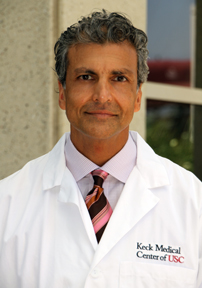By Josh Grossberg
Pacemakers and defibrillators are fairly common life-saving devices these days, but when Rahul N. Doshi, MD, was getting his start in the medical profession, they both relied on fairly rudimentary technology. A self-described tech geek, Doshi knew the field of electrophysiology was on the cusp of great change, and he wanted to be part of it.
As the new director of electrophysiology at the Keck Medical Center of USC, Doshi will help guide the future of this exciting field that is advancing in ways he couldn’t have imagined.
“It’s a relatively new and fast-growing sub-subspecialty of cardiovascular medicine,” he said. “It’s very different from what the interventional cardiologists do. They look at arteries and pipes; I look at the heart’s internal wiring.”
Electricity is what makes the heart pump, and it can be manipulated to help regulate its movements. In addition to pacemakers and defibrillators becoming smaller, more complex and ubiquitous, Doshi said that doctors can now target specific areas of the heart that cause it to beat irregularly.

Rahul N. Doshi has big plans for expanded use of new technology as the new director of electrophysiology at the Keck Medical Center of USC.
(Photo/Jon Nalick)
“We’re using technology to essentially burn or freeze parts of the heart that are responsible for these abnormal rhythms,” he said. “This technology has grown tremendously over the last decade. Catheter ablation is one of the fastest growing procedures in cardiovascular medicine.”
As with all electronics, the devices that Doshi uses to keep the heart pumping continue to evolve. For example, he keeps a small device in his briefcase that can turn his iPhone into an EKG monitor.
Doshi received his medical degree from Stanford University School of Medicine. He arrived at the Keck Medical Center after serving as director of electrophysiology at UC Irvine and St. Jude Medical Center. A fellow of both the American College of Cardiology and the Heart Rhythm Society, Doshi has experience in all areas of electrophysiology, including complex ablation and implantable device therapy. He is active on numerous committees and advisory boards, and has published dozens of peer-reviewed articles.
In his new job, he oversees four electrophysiologists, a lab team and other support staff. “We’re rapidly expanding,” he said. “It’s amazing how far things are going. The potential demand is huge, especially here at USC.”

